To capture stunning aerial volleyball shots, you'll need a high-quality drone with a stable camera, and a full-frame DSLR or mirrorless camera with a wide-angle lens. Operate at 15-30 feet indoors or 30-50 feet outdoors, adjusting for the best court view. Use fast shutter speeds (1/1000th or higher) to freeze action, and set your aperture between f/8 and f/11 for depth. Compose shots using court lines as guides and apply the rule of thirds. Focus on dynamic formations, anticipate plays, and capture key moments like serves and spikes. Remember to follow drone regulations and prioritize safety. Discover more techniques to elevate your volleyball photography game.
Essential Equipment for Aerial Volleyball Photography
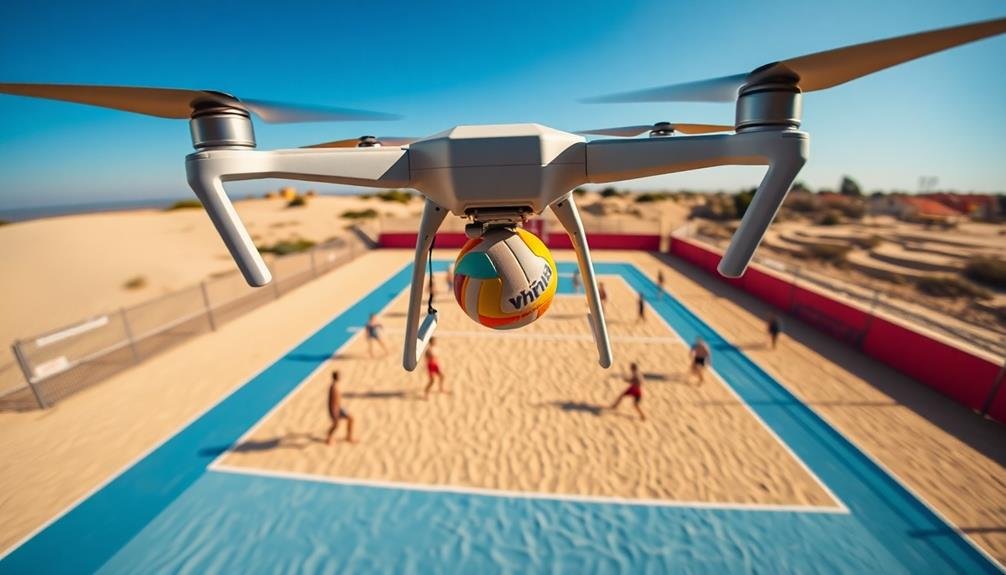
Capturing the perfect aerial shot of a volleyball match requires specialized gear.
You'll need a high-quality camera with fast shutter speeds and excellent low-light performance. A full-frame DSLR or mirrorless camera is ideal, paired with a wide-angle lens (16-35mm) to capture the entire court. Don't forget spare batteries and memory cards.
For aerial shots, you'll need a drone capable of stable flight and high-quality image capture. Look for models with obstacle avoidance and intelligent flight modes.
Make certain you have extra propellers and batteries for extended shooting sessions. A reliable remote controller with a built-in screen or smartphone mount is essential for framing your shots.
Consider investing in ND filters to manage bright outdoor lighting conditions. To protect your equipment, invest in a sturdy carrying case.
You'll also need a laptop or tablet for on-site image review and basic editing. Lastly, don't overlook safety gear.
Wear a high-visibility vest and have proper documentation, including drone registration and any necessary permits for aerial photography at the venue.
Drone Regulations for Sports Events
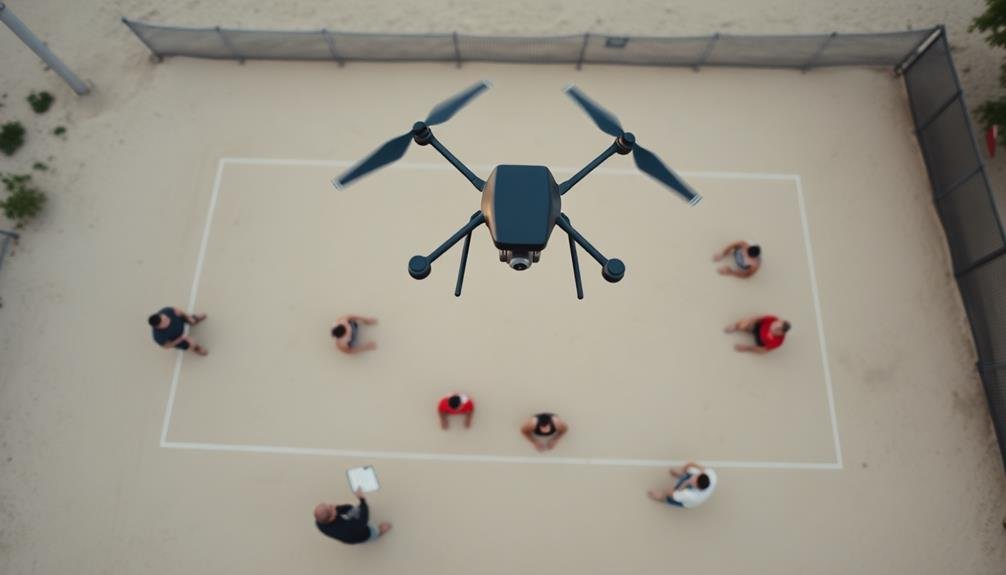
Before you launch your drone at a volleyball event, you'll need to understand the airspace restrictions in place.
You must obtain proper certification and permissions from relevant authorities to operate legally.
Familiarize yourself with local and national regulations to guarantee compliance and avoid potential fines or legal issues.
Airspace Restrictions
Steering through the complex web of drone regulations is essential when photographing volleyball events from the air. You'll need to be aware of airspace restrictions that can affect your ability to capture aerial shots.
First, check if the venue is within controlled airspace, such as near airports or military bases. If so, you'll need to obtain proper clearance before flying.
Many sports facilities have their own airspace restrictions, even if they're not in controlled areas. You'll need to contact the venue management to get permission and understand any specific rules they may have. Some places might require you to fly at certain heights or limit your flight time.
Be mindful of temporary flight restrictions (TFRs) that can be put in place for large events. These can change quickly, so always check for updates before each flight.
You should also be aware of no-fly zones around stadiums during professional sporting events.
Certification and Permissions
To legally operate your drone for aerial volleyball photography, you'll need more than just awareness of airspace restrictions. Proper certification and permissions are essential.
First, obtain your Remote Pilot Certificate from the FAA by passing the Part 107 exam. This credential demonstrates your understanding of drone regulations and safety protocols.
Next, secure written permission from the event organizers and venue management. They may have specific requirements or limitations for drone usage during matches. Some venues might prohibit drones altogether, so always check in advance.
If you're photographing a professional or collegiate volleyball event, you'll likely need media credentials. Contact the league or school's media relations department to apply for these.
For indoor volleyball events, additional considerations apply. You'll need explicit permission from the building owner and event organizer, as indoor drone flight falls under different regulations.
Make sure you're familiar with the FAA's rules for flying drones indoors.
Lastly, respect players' and spectators' privacy. Obtain necessary releases if you plan to use images commercially.
Choosing the Right Altitude
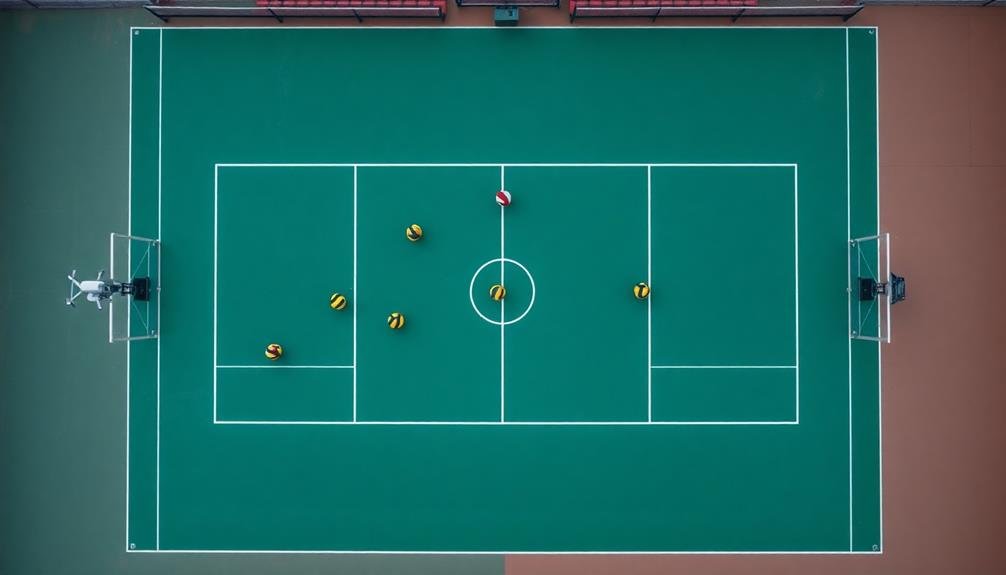
When it comes to aerial volleyball photography, selecting the appropriate altitude is essential for capturing the perfect shot. You'll need to balance getting a clear view of the entire court with maintaining enough detail to showcase player movements and ball trajectories.
Start by considering the venue's size and lighting conditions. For indoor matches, you'll typically fly lower than outdoor games due to ceiling constraints. Aim for an altitude between 15-30 feet for indoor courts and 30-50 feet for outdoor venues. Remember, higher altitudes provide a wider field of view but may sacrifice image quality.
Experiment with different heights to find the sweet spot that captures both the court's layout and player interactions. Use your drone's live feed to adjust your position in real-time, ensuring you're framing the action effectively.
| Altitude (feet) | Indoor | Outdoor | Image Quality |
|---|---|---|---|
| 10-15 | Good | Limited | Excellent |
| 15-30 | Best | Good | Very Good |
| 30-50 | N/A | Best | Good |
| 50+ | N/A | Wide | Fair |
Always prioritize safety and adhere to local regulations when choosing your altitude. Don't forget to account for obstacles like lighting fixtures, scoreboards, or overhead wires that may impact your flight path.
Camera Settings for Action Shots
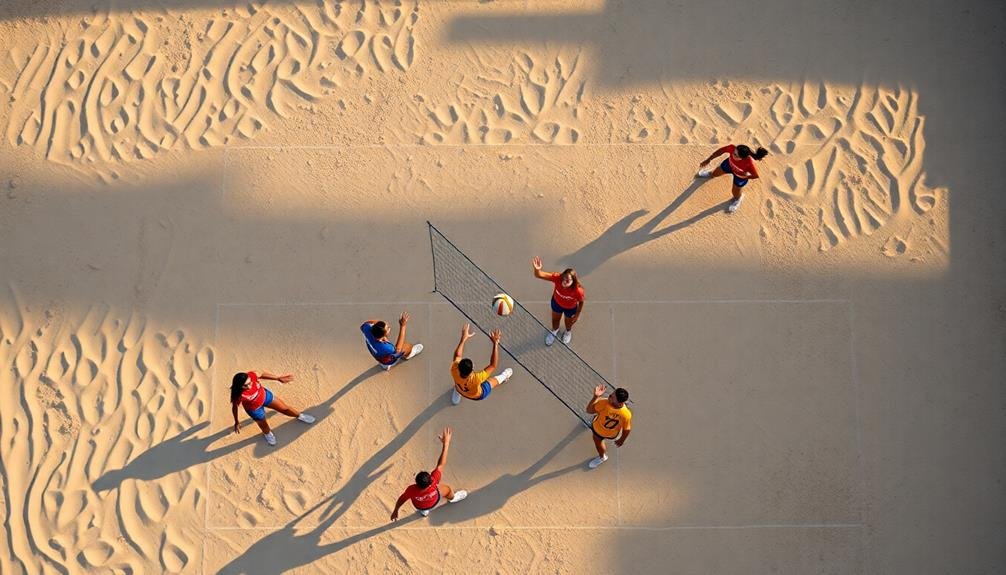
When capturing aerial volleyball action shots, you'll need to master key camera settings.
Start by adjusting your shutter speed to freeze fast-moving players and the ball in mid-air.
Next, consider your aperture choice to balance depth-of-field with light intake, especially for indoor matches where you might need to bump up your ISO for proper exposure.
Shutter Speed Considerations
Capturing the fast-paced action of volleyball from above requires mastering the art of shutter speed. You'll need to strike a balance between freezing the action and maintaining image quality. For aerial volleyball shots, aim for a shutter speed of at least 1/1000th of a second to freeze players mid-air and capture crisp ball movement.
If you're shooting in bright outdoor conditions, you can push your shutter speed even higher, up to 1/2000th or 1/4000th of a second. This will guarantee razor-sharp images of quick serves and powerful spikes.
However, in indoor venues with less light, you may need to compromise. Don't drop below 1/500th of a second, as this risks introducing motion blur.
Remember that higher shutter speeds mean less light reaches the sensor. To compensate, you'll need to increase your ISO or open up your aperture.
Find the sweet spot where you can maintain a fast shutter speed without introducing too much noise or sacrificing depth of field. Experiment with different settings during warm-ups to determine the best combination for your specific lighting conditions and desired artistic effect.
Aperture and Depth-Of-Field
For aerial volleyball photography, aperture settings play an essential role in achieving the desired depth-of-field and overall image quality. You'll want to balance capturing the action while maintaining sharpness across the court. A wider aperture (lower f-number) allows more light in, enabling faster shutter speeds, but reduces depth-of-field. Conversely, a narrower aperture (higher f-number) increases depth-of-field but requires more light.
For aerial shots, you'll typically want a larger depth-of-field to keep multiple players in focus. Start with an aperture around f/8 to f/11, adjusting based on lighting conditions and your creative vision. Remember, the higher you are, the easier it is to achieve a wider depth-of-field.
| Aperture | Depth-of-Field | Light Sensitivity |
|---|---|---|
| f/2.8 | Shallow | High |
| f/8 | Medium | Moderate |
| f/16 | Deep | Low |
Experiment with different apertures to find the sweet spot for your aerial volleyball shots. If you're focusing on a specific player or action, a wider aperture can help isolate the subject. For team-wide shots or to capture the entire court, opt for a narrower aperture. Don't forget to adjust your ISO and shutter speed accordingly to maintain proper exposure.
ISO for Indoor Matches
In the domain of indoor volleyball photography, ISO settings become essential for capturing fast-paced action in often challenging lighting conditions.
You'll typically need to use higher ISO values to compensate for the dimmer indoor environment and to maintain faster shutter speeds.
Start by setting your ISO between 1600 and 3200, depending on the venue's lighting. If you're shooting in a well-lit professional arena, you might get away with ISO 1600. However, in poorly lit school gymnasiums, you may need to push it to 3200 or even higher.
Don't be afraid to increase your ISO further if necessary. Modern DSLR and mirrorless cameras can produce usable images at ISO 6400 or even 12800. Remember, a slightly noisy image is better than a blurry one.
To minimize noise, use your camera's noise reduction features judiciously. In-camera noise reduction can sometimes soften details, so you might prefer to handle this in post-processing.
Lastly, consider using prime lenses with wide apertures (f/2.8 or wider) to gather more light, allowing you to keep your ISO lower while maintaining fast shutter speeds for crisp action shots.
Composition Techniques for Volleyball Matches
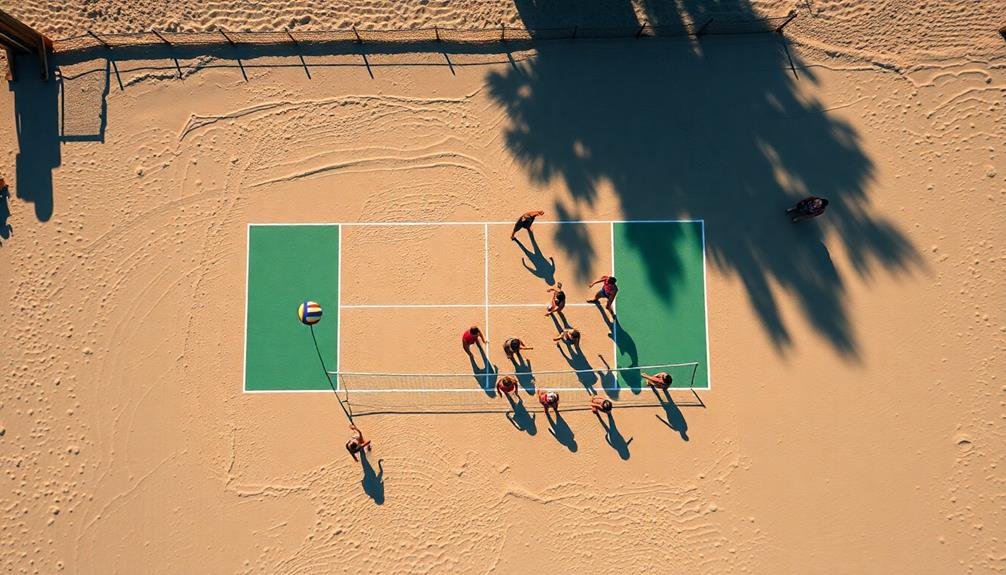
When composing aerial shots of volleyball matches, you'll need to master several key techniques to create visually striking images. Focus on capturing the entire court to provide context and showcase the players' positions. Use the court lines as natural leading lines to guide the viewer's eye towards the action. Pay attention to the rule of thirds, placing key elements like the net or active players along these imaginary lines for a more balanced composition.
Consider the following visual elements to enhance your aerial volleyball shots:
- The dynamic formations of players as they move across the court
- The contrast between the court's surface and the players' uniforms
- The shadows cast by players, which can add depth and drama to the image
Experiment with different angles and heights to find the most engaging perspective. Capture both wide shots of the entire court and tighter frames focusing on specific plays or player interactions.
Don't forget to anticipate the action – position yourself to capture serves, spikes, and blocks at their peak moments. By mastering these composition techniques, you'll create enthralling aerial volleyball photographs that tell the story of the match from a unique vantage point.
Tracking Player Movements From Above
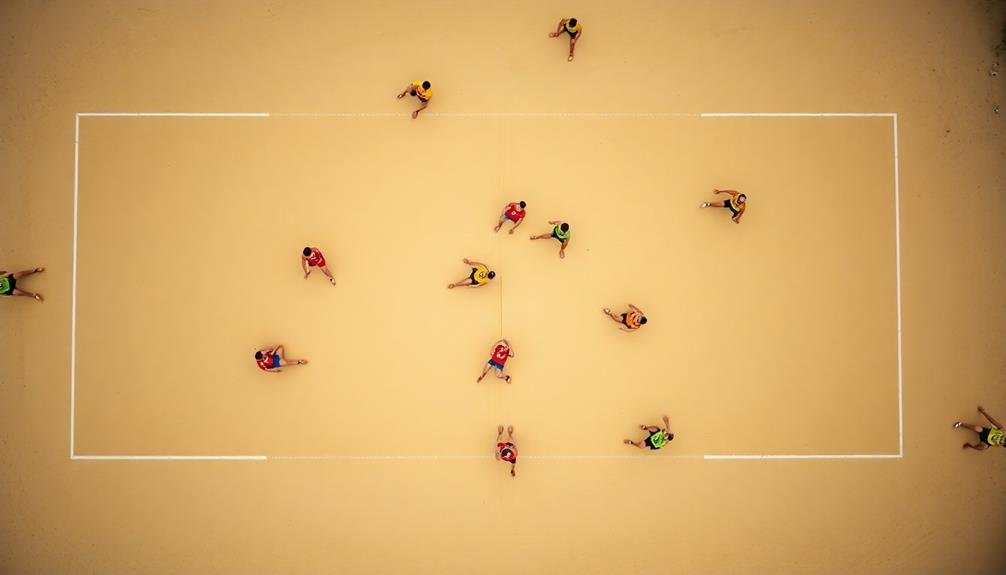
Mastering the art of tracking player movements from above is essential for capturing dynamic volleyball action shots. You'll need to anticipate plays and position yourself accordingly.
Start by studying the game's flow and team strategies to predict where the action will unfold. Use a high shutter speed to freeze fast-paced movements. A speed of 1/1000th of a second or faster is ideal for capturing sharp images of leaping players and powerful spikes.
Employ continuous autofocus to keep players in focus as they move across the court. Consider using a wide-angle lens to capture the entire court, allowing you to track multiple players simultaneously. Alternatively, a telephoto lens can help you focus on specific players or areas of intense action.
Pan your camera smoothly to follow the ball's trajectory and the players' movements. This technique will help you maintain composition and catch key moments. Don't forget to adjust your camera's settings as lighting conditions change throughout the match.
Experiment with different angles and heights to find the most compelling perspectives. You might use a drone or elevated platform for a true bird's-eye view, offering a unique take on player formations and court coverage.
Capturing Serve and Spike Moments
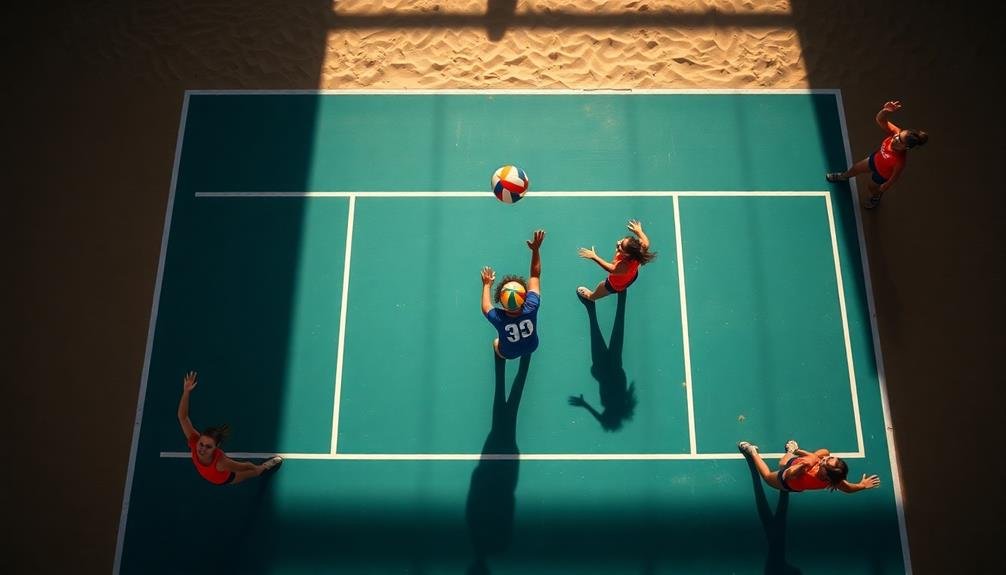
With serve and spike moments being the most explosive actions in volleyball, capturing them requires precise timing and technique. You'll need to anticipate these actions and position your drone accordingly.
For serves, hover your drone near the serving player, slightly offset to capture both the server and the ball's trajectory. For spikes, position the drone above the net, angled towards the attacking team's side.
To freeze the action, use a fast shutter speed of at least 1/1000th of a second. Adjust your ISO and aperture to compensate for the quick shutter. Continuous shooting mode is essential, as it allows you to capture multiple frames and select the best moment later.
Consider these visual elements when composing your shots:
- The player's body position and muscle tension
- The ball's deformation upon impact
- The opposing team's defensive stance
Pay attention to lighting conditions, especially if you're shooting indoors. Use your drone's gimbal to maintain a steady frame during rapid movements.
Remember to respect tournament rules and maintain a safe distance from players. With practice, you'll develop an instinct for anticipating and capturing these high-energy volleyball moments from above.
Highlighting Court Patterns and Formations
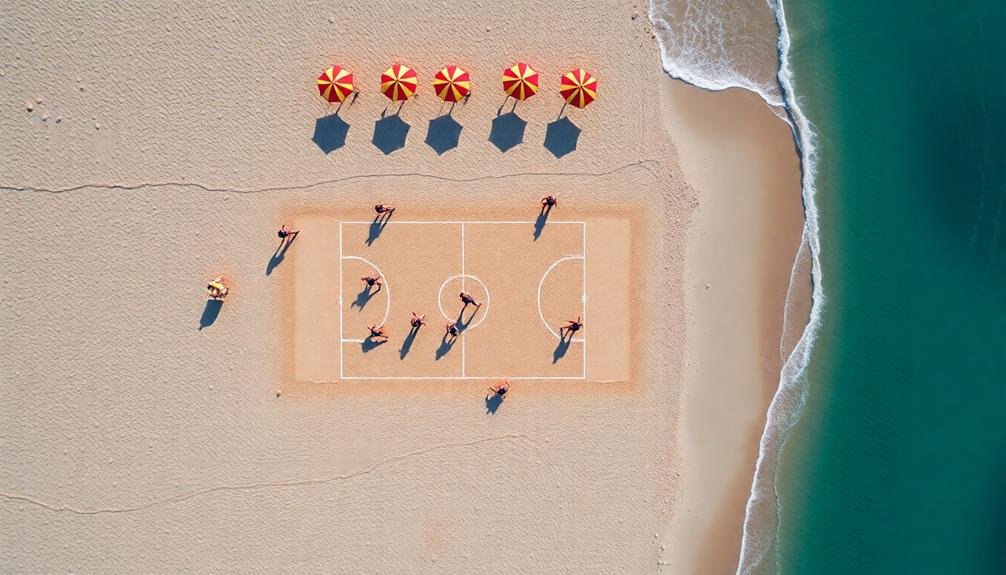
From high above, volleyball courts transform into geometric canvases, revealing intricate patterns and formations that aren't visible from the ground. As an aerial photographer, you'll want to capture these unique perspectives to showcase the tactical aspects of the game.
Focus on positioning your drone or elevated camera to highlight the symmetry of the court layout. You'll see the distinct zones, attack lines, and service areas forming a structured grid. Look for moments when players align in classic formations like the 5-1 or 6-2 setups. These configurations create visually striking shapes when viewed from above.
Pay attention to defensive formations during rallies. You'll notice how players shift and rotate, creating dynamic patterns as they cover the court. Capture the contrast between offensive and defensive positioning, especially during serve reception.
Don't forget to showcase the negative space around players. This emphasizes their positioning and movement across the court. Use wide-angle shots to encompass the entire playing area, allowing viewers to appreciate the full scope of team strategies.
Experiment with different altitudes to find the sweet spot that best illustrates these patterns while maintaining image clarity and detail.
Post-Processing Aerial Volleyball Images

When post-processing your aerial volleyball images, you'll want to focus on enhancing court visibility and perfecting player positioning.
Start by adjusting contrast and brightness to make the court lines more distinct, ensuring the playing area stands out clearly.
Next, fine-tune player positions using subtle adjustments to highlight formations and key moments in the game.
Enhancing Court Visibility
After capturing stunning aerial volleyball shots, you'll often need to enhance court visibility during post-processing.
Start by adjusting the contrast and brightness to make the court lines more distinct. Use the clarity slider to bring out texture in the sand or indoor flooring. Don't forget to sharpen the image, focusing on the court boundaries and player positions.
Next, consider using selective color adjustments to make the court stand out. Boost the saturation of the court's dominant colors, typically blue for indoor courts or beige for beach volleyball. You can also desaturate the surrounding areas to draw attention to the playing surface.
To create depth and dimension in your aerial volleyball images:
- Enhance shadows and highlights to accentuate the 3D nature of players and equipment
- Apply a subtle vignette to direct focus towards the center of the court
- Use radial filters to brighten the main action areas
Perfecting Player Positioning
Focusing on player positioning is essential when post-processing aerial volleyball images. You'll want to guarantee that players are clearly visible and their positions on the court are accurately represented. Start by adjusting the contrast and shadows to make players stand out from the court background. Use selective sharpening to enhance the clarity of player outlines and uniforms.
Next, consider cropping the image to emphasize key player formations or strategic positioning. You can use the rule of thirds to create a more dynamic composition. Don't forget to straighten the court lines if they appear skewed due to the aerial perspective.
Here's a quick guide to player positioning in different game scenarios:
| Scenario | Offensive Positioning | Defensive Positioning |
|---|---|---|
| Serve | 3 front, 3 back | 3 front, 3 back |
| Attack | Hitter up front | Block formation |
| Rally | Spread out | Ready stance |
When editing, pay attention to these formations and guarantee they're clearly visible. You can use subtle color adjustments to differentiate between teams if necessary. Finally, consider adding subtle vignetting to draw the viewer's eye towards the center of the action, where player positioning is most important.
Storytelling Through Aerial Match Coverage
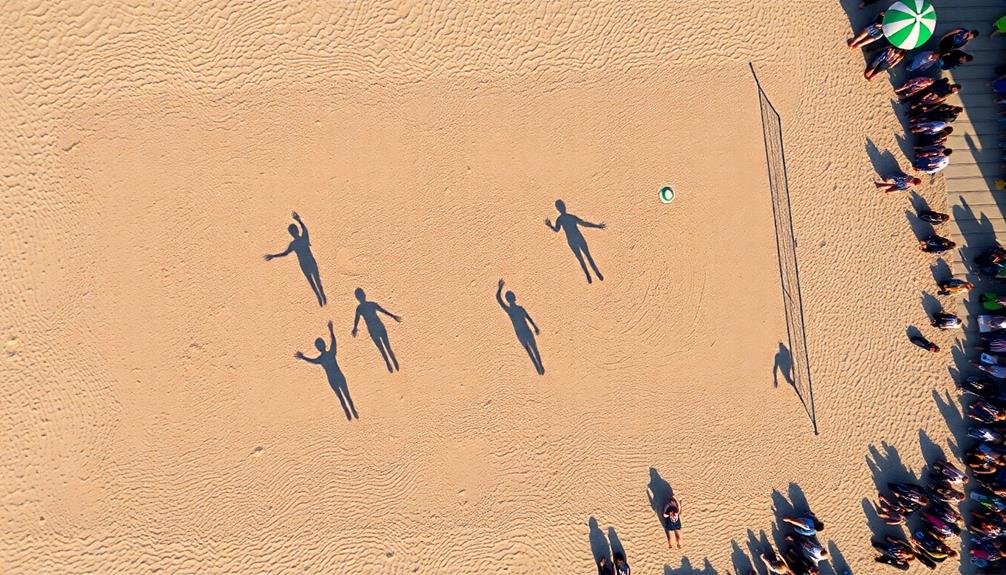
Aerial volleyball photography offers a unique opportunity to capture the drama and intensity of a match from above. As you hover over the court, you're in a prime position to tell the story of the game through your lens. Focus on capturing key moments that illustrate the match's narrative arc, from the opening serve to the final point.
Look for patterns and formations that emerge during play. You'll want to capture:
- The team's defensive setup, showcasing their strategy
- The setter's positioning as they prepare to set up an attack
- The blockers' positioning at the net, ready to counter the opponent's spike
Don't just snap random shots; anticipate the action. Track the ball's movement and be ready to capture the split-second decisions players make. Pay attention to the players' body language and facial expressions, which can convey the emotional highs and lows of the match.
Remember to vary your shots. Combine wide-angle views that show the entire court with close-ups of individual players in action. This mix will give your audience a thorough view of the match, telling a complete story from your unique aerial perspective.
Safety Considerations for Drone Operation

Safety must be your top priority when operating a drone for aerial volleyball photography. Always follow local regulations and obtain necessary permits before flying. Make certain you're familiar with your drone's features and limitations, and maintain visual line of sight at all times.
Before takeoff, inspect your equipment thoroughly and check weather conditions. Never fly over spectators or players, and maintain a safe distance from the court. Be aware of your surroundings, including obstacles and other aircraft.
Here's a quick reference guide for safe drone operation:
| Safety Aspect | Indoor Matches | Outdoor Matches |
|---|---|---|
| Flight Ceiling | Venue height | 400 feet AGL |
| No-fly Zones | Spectator areas | Nearby airports |
| Wind Limits | N/A | 15-20 mph max |
| Battery Life | 20-30 minutes | 15-25 minutes |
| Emergency Protocol | Land immediately | Return to home |
Remember to respect privacy and obtain necessary permissions from event organizers and participants. Always have a spotter to assist you during flights, and be prepared to abort the mission if any safety concerns arise. By prioritizing safety, you'll make certain a successful and responsible aerial volleyball photography experience.
Frequently Asked Questions
How Do Weather Conditions Affect Aerial Volleyball Photography?
Weather conditions greatly affect your aerial volleyball photography. Wind can disrupt your drone's stability, while rain or snow can damage equipment. Bright sunlight may cause glare, and overcast skies can reduce contrast. You'll need to adapt to these challenges.
What Insurance Considerations Should Photographers Have for Aerial Sports Coverage?
You'll need thorough liability insurance for your drone and equipment. Don't forget personal injury coverage. It's vital to have protection against potential lawsuits from accidents or property damage. Always check local regulations for specific requirements.
How Can Aerial Photos Be Integrated With Traditional Ground-Level Volleyball Photography?
You can blend aerial and ground-level volleyball photos by creating multi-perspective collages, alternating shots in slideshows, or using aerial images for overview layouts. Combine them to tell a detailed story of the match's action and atmosphere.
What Are the Best Practices for Obtaining Player Consent for Aerial Imagery?
To obtain player consent for aerial imagery, you'll need to provide clear information about how it'll be used. Get signed releases from players or their guardians. Respect privacy concerns and offer opt-out options when possible.
How Do Different Volleyball Court Surfaces Appear in Aerial Photographs?
You'll notice distinct differences in aerial photos of volleyball courts. Indoor wood courts appear glossy and uniform. Outdoor sand courts show a grainy texture. Grass courts display varying shades of green. Synthetic surfaces often have vibrant, consistent colors.
In Summary
You've now got the tools to capture stunning aerial volleyball shots. Remember to prioritize safety, follow regulations, and respect players' privacy. With practice, you'll master the art of framing dynamic plays from above. Don't forget to experiment with different angles and altitudes to tell the match's story. Your unique perspective will bring a fresh dimension to volleyball coverage. Keep honing your skills, and you'll soon be creating breathtaking aerial sports photography.

As educators and advocates for responsible drone use, we’re committed to sharing our knowledge and expertise with aspiring aerial photographers.




Leave a Reply